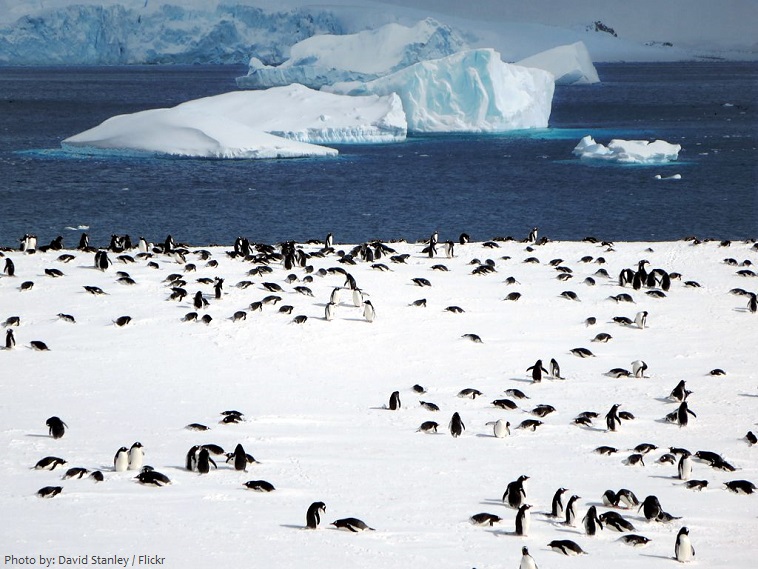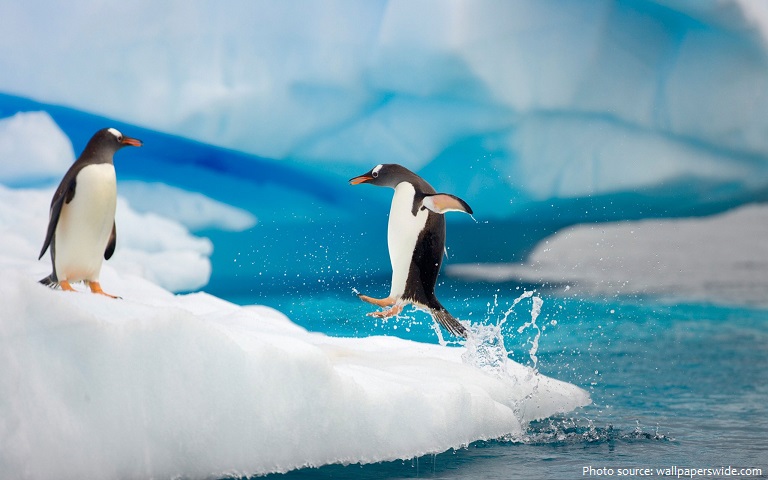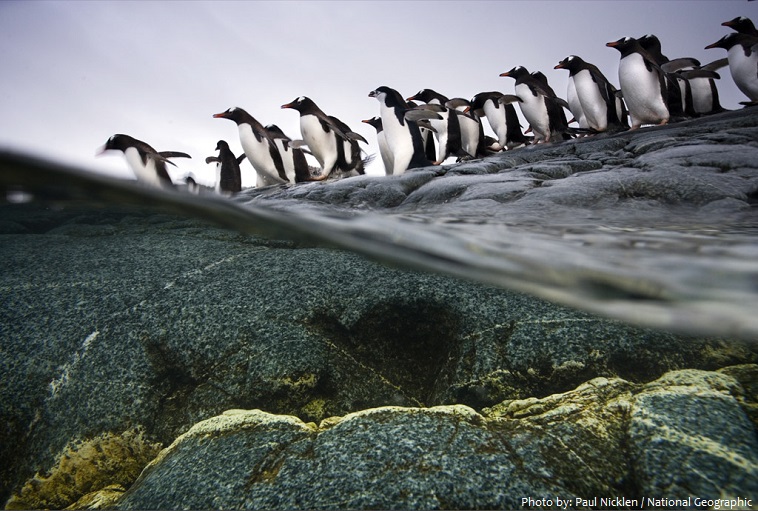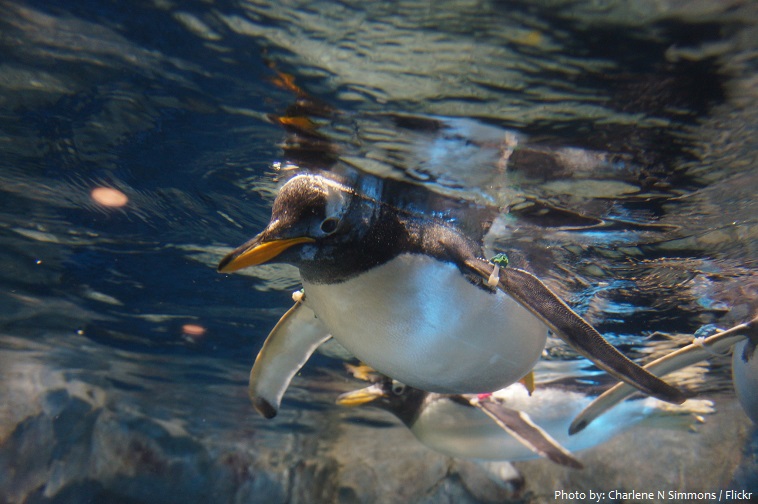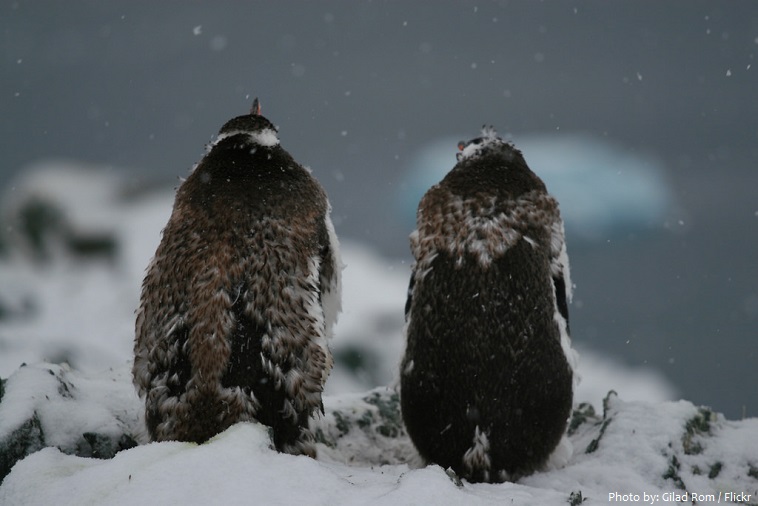The gentoo penguin (Pygoscelis papua) is the third largest penguin species (after emperor and king penguins).
Gentoo penguins are found on the Antarctic Peninsula as well as many sub-Antarctic islands.
The largest populations of gentoo penguins are found at the Falkland/Malvinas Islands, South Georgia, and the Antarctic Peninsula.
Gentoo penguin’s habitats include ice or snow covered grounds as wall as ice-free areas such as coastal plains, sheltered valleys, and cliffs.
They gather in colonies of breeding pairs that can number from a few dozen to many thousands.
With a total breeding population of approximately 387 000 pairs gentoo penguins are the least abundant of the penguins found on the sub-Antarctic islands.
Gentoos reach a height of 51 to 90 cm (20 to 35 in); they average 75 cm (about 30 inches)
While the average adult weighs about 5 kilograms (11 pounds), some adults can weigh as much as 8.5 kg (about 19 pounds) just before the beginning of the molting period, which occurs just after the young are old enough to leave the nest.
Although males are roughly 0.5 kg (1.1 pounds) heavier than females, both sexes closely resemble one another.
Like all penguin species, the ventral side of gentoo penguins is white while the dorsal side is black. This color pattern is known as countershading. This adaptation is useful while swimming underwater; the lightly colored ventral side helps penguins blend in with the sky for predators or prey that are looking up. The dark dorsal side blends in with the ocean floor for predators or prey looking down.
The gentoo penguin is easily recognized by the wide white stripe extending like a bonnet across the top of its head and its bright orange-red bill. It has pale whitish-pink webbed feet and a fairly long tail – the most prominent tail of all penguins.
Gentoo Penguins are the fastest underwater swimming penguins, reaching speeds of 36 km/h (22 mph).
They have been known to make up to as many as 450 dives in one day to forage for food.
Gentoo Penguins can dive as deep as 200 meters and stay underwater up to 7 minutes.
During deep dives, gentoo penguins reduce their heart rate from 80-100 beats per minute (bpm) down to 20 bpm.
The diet of gentoos varies with season and location but is usually a mix of crustaceans, small fish and squid.
Gentoo penguins live most of their life in the same place where they breed. These penguins are very social, and they usually do not show aggression among themselves or with other species of penguins, except when protecting their nests or eggs.
The gentoo penguin calls in a variety of ways, but the most frequently heard is a loud trumpeting which is emitted with its head thrown back.
The breeding colonies of gentoo penguins are located on ice-free surfaces. Colonies can be directly on the shoreline or can be located considerably inland. They prefer shallow coastal areas and often nest between tufts of grass. In South Georgia, for example, breeding colonies are 2 km (1.2 mi) inland.
Gentoo penguins are monogamous during a breeding season, with some pair bonds lasting a lifetime. The females produce two eggs. The parents share incubation, changing duty daily. The eggs hatch after 34 to 36 days. The chicks remain in the nests for about 30 days before forming créches. The chicks molt into subadult plumage and go out to sea at about 80 to 100 days.
Gentoo penguin eggs are taken by skuas. Young birds are preyed upon by sheathbills, caracaras, kelp gulls, giant-petrels, skuas and feral cats, while older birds are taken by leopard seals and killer whales. Nests are often flattened by indifferent elephant seals as they move about the island.
After completion of the breeding season, adults spend time at sea building up body fat reserves prior to undergoing their annual moult. The moult takes around 2 to 3 weeks, and during this time birds spend considerable amounts of time tending to their plumage.
The feathers of gentoos are very fine; every square inch of their body can be covered with up to 70 feathers.
Gentoo penguins live up to their Latin name pygoscelis, meaning brush tailed. They have the most prominent tail of all penguins, which sticks out behind and sweeps from side to side as they walk.
The application of gentoo to the penguin is unclear. The Oxford English Dictionary notes that gentoo used to be an Anglo-Indian term used as early as 1638 to distinguish Hindus in India from Muslims. The English term may have originated from the Portuguese gentil (compare “gentile”).
The scientific description of the gentoo penguin was first made by the German naturalist Johann Reinhold Forster in 1781 who accompanied Captain James Cook on his second Pacific voyage.
The IUCN Red List lists the Gentoo as least concern, although rapid declines in some key populations are believed to be driving a moderate overall decline in the species population.
All 18 species of penguin are legally protected from hunting and egg collecting.
